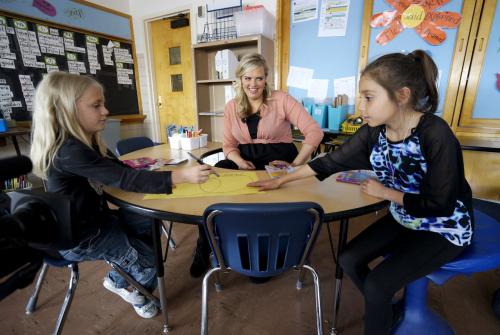I am a “glass is half full” kind of person. While uncertainty and fear from the coronavirus epidemic is of course top of mind, I have also seen many acts of human kindness on social media and on trips to the supermarket, library, or just walking my dog that give me hope. One of the biggest stories along these lines was the recent announcement that Eric Yuan, the CEO of Zoom, is giving K-12 schools free access to videoconferencing tools to help support learning for the millions of out-of-school children across the U.S. On a more local level, it has been inspiring to see posts on my neighborhood Nextdoor group of people offering to do grocery runs, pick up prescriptions, or lend a helping hand to anyone in need.
As a developmental psychologist with expertise in creativity and playful learning, I wanted to do my part and offer some tips based on research for supporting young children’s learning through interactive and fun activities while families shelter in place at home.
Promote helping behaviors
Increasingly, research indicates that children with social-emotional skills do better in school, in the workplace, and in life. Fortunately, like many other skills, social-emotional skills are malleable, and caregivers can foster them in young children through everyday interactions.
The simple act of talking about emotions and mental states in everyday contexts can develop children’s “helping” tendencies. Research measured toddler’s empathic response (e.g., bringing a blanket to the experimenter when she shivered) and found that when parents elicited talk about their emotions while reading a book together, children helped more quickly. When reading a book or watching a movie with your child, pause to ask questions like, “How do you think that character was feeling?” or “How would you feel if that happened to you?”
While parents may equate hearing the phrase “I’m bored” with nails on a chalkboard, the good news is that boredom can spark creativity.
Research also suggests that adult scaffolding (supporting children in developmentally appropriate ways) while doing chores around the house promotes sharing and helping behaviors in young children. Young children are often eager to “help” their parents with chores around the house like cleaning and folding laundry. While these genuine efforts may be more counterproductive than helpful, this parent-child interaction may promote helping behaviors.
Look for opportunities for your child to help in the kitchen (e.g., measure or mix ingredients) or with daily chores (e.g., taking out the trash, feeding pets) even if the task might take a bit longer—that extra time will likely pay off in the long run.
Build math and spatial skills
While math may not sound like a lot of fun, your child can build his or her math skills by playing with blocks. Developing spatial skills—the ability to mentally manipulate shapes and objects in the environment—is an important component of mathematical understanding. A number of training studies with kindergarteners and first-graders indicates that playful activities like building with blocks and other construction toys (e.g., Wikki Stix) are linked to better spatial and math skills.
Research also shows that talking about spatial relations—using terms like “next to,” “above,” or “under”—can help improve spatial reasoning. For example, parents’ use of spatial language in the toddler years predicts children’s later use of spatial language, which in turn is linked to better spatial reasoning. Other developmental studies on guided play—a type of play where adults support children’s learning by setting learning goals and scaffolding the environment while allowing children to maintain control over their learning—indicate that parents and children tend to use more spatial language in guided play compared to free play. Search through your closets and garage for bins of blocks, construction sets, and puzzles and let the building begin!
Boost creativity
Children have unlimited creative potential, but unfortunately they don’t have many opportunities to develop their creative thinking in traditional classrooms. While there are many uses and meanings of the term “creativity,” parents, educators, and business leaders agree that creativity is a critical 21st century skill in today’s rapidly changing world.
Young children often express their creativity and imagination through pretend play. A series of longitudinal studies starting in early grade school showed that pretend play is predictive of divergent thinking (i.e., generating creative ideas by exploring many possible solutions) and original thinking over time. More specifically, the quality of imagination and fantasy in early pretend play predicted divergent thinking over a four-year period (from grades one and two to grades five and six). Provide time and space for your children to engage in fantasy play and don’t be shy about joining their tea party or trip to the moon.
“I’m bored” will probably be one of the most common phrases parents hear as the days, weeks, and possibly months pass with no school. While parents may equate hearing this phrase with nails on a chalkboard, the good news is that boredom can spark creativity. In a recent study with adults, researchers found that participants who were asked to sort a bowl of beans by color, one by one (meant to induce boredom) later performed better on an idea-generating task than others that were given an interesting, craft activity to complete. Try fighting your first instinct as a parent to fill the void and surprise your child by saying something like, “Being bored is good for you!”
While unexpectedly spending weeks or months out of school is never good, the silver lining is that parents can still support learning at home through fun and interactive activities. Families that read books, do chores, and play together—or even grow bored together—can foster critical skills that will serve children well long into adulthood.
The Brookings Institution is committed to quality, independence, and impact.
We are supported by a diverse array of funders. In line with our values and policies, each Brookings publication represents the sole views of its author(s).








Commentary
Time to talk, play, and create: Supporting children’s learning at home
March 19, 2020